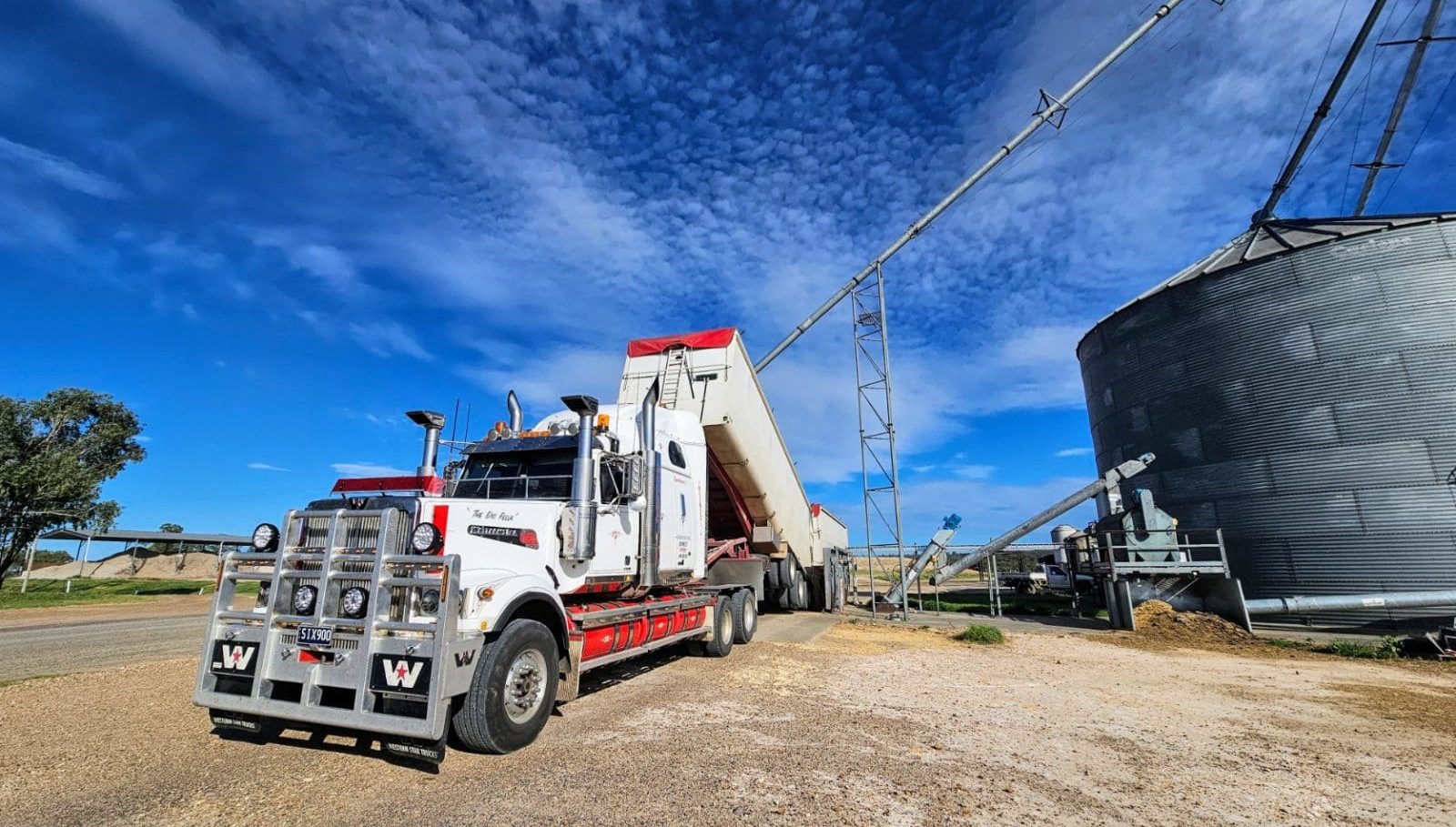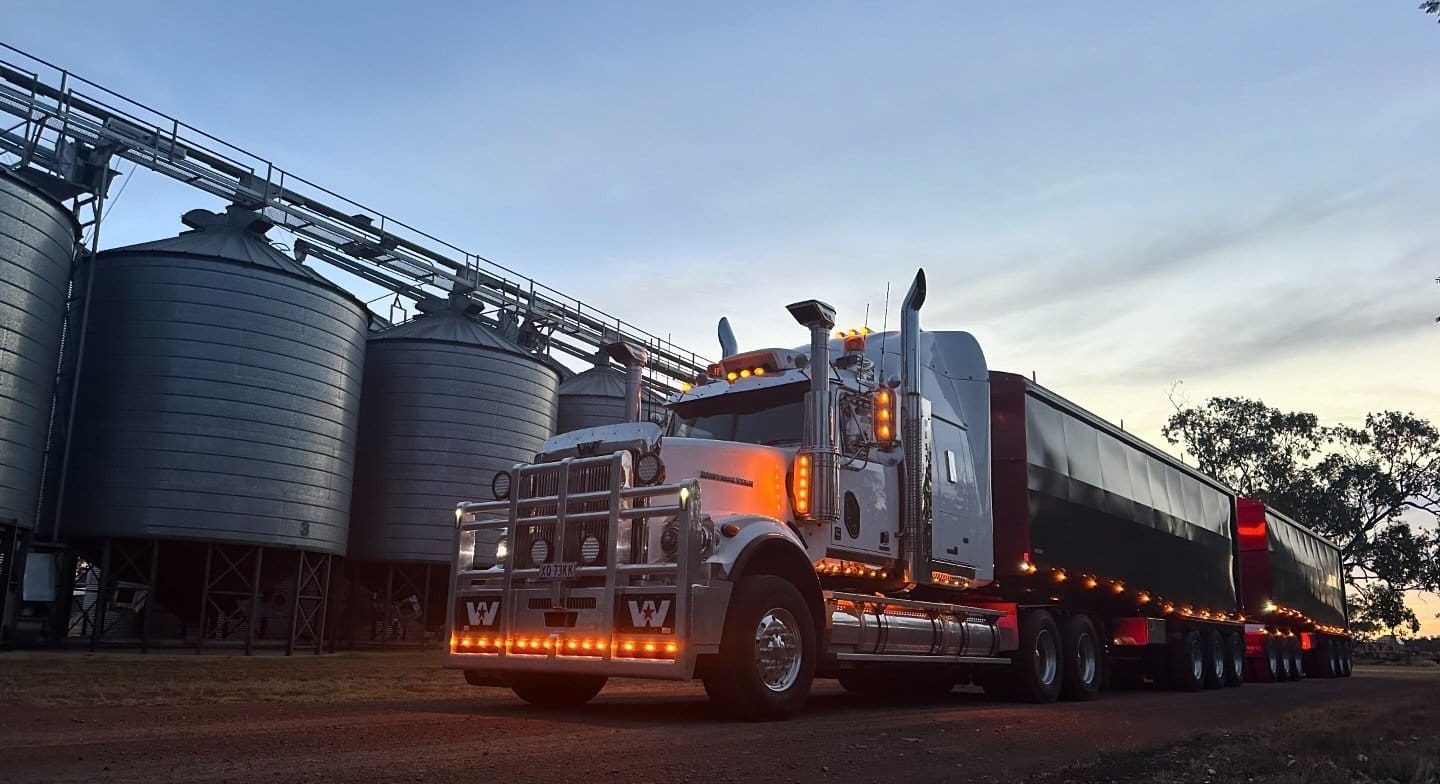
In this low-export period, carriers in southern Qld are relying on demand generated by the domestic consumer. Photo: Eastwells Haulage
INDUSTRY estimates say up to 100 grain trucks have been “parked up” or redeployed in southern Queensland in recent months in response to a drop-off in work, and rates seen by some to be too low to keep the wheels turning.
While rates of up to 22 cents per kilometre per tonne were seen from spring 2021 to winter 2023, when a massive export task swelled the fleet centred on the Darling Downs, freight has in recent times been booked for as little as 7c/km/t.
Bringing hope to the sector are prospects for a big and timely plant of winter crop across southern Qld and northern New South Wales, with wheat, barley and chickpeas expected to hit the bins in October.
Ahead of sorghum and cottonseed lifting nearby demand for road transport, operators say the freight market appears to be consolidating at around 14-15c/km, and the value of their relationships with growers, traders and consumers has kept many rolling through three tough quarters.
Less wheels on road
Queensland Trucking Association chief executive officer Gary Mahon said some operators in the grain sector are hauling loads at below cost.
“That’s necessitating some people to park their vehicles up, and other people are moving into other areas with different commodities, or different geographic areas,” Mr Mahon said.
While some fleets are ticking along as usual, or even expanding, Mr Mahon said some operators have permanently or temporarily reduced their grain fleet, with the cost of finance a consideration.
“Some are parking their bins for the time being.”
While other sectors, like general freight and mining, work mostly on longer-term contracts, Mr Mahon said grain business was primarily done on “ad hoc” rates that operators were having to calculate based on their own bottom line and their appetite for business.
At Condamine, grower and Rebel Seeds director Andrew Butler these days runs one truck, after having sold three in recent times.
“We haven’t done a load of grain for a trader for months, and 15c/km is where we stopped,” Mr Butler said.
“That 7-8/km you’ve heard is true; at 7c/km now, I don’t know how they’re turning the key for that.”
“The export program stayed so strong for so long, and as soon as that market was satisfied, it dropped like a stone.”
Mr Butler said the cheap rates hold huge appeal to the trader, which can either offer more to growers at pick-up, or less to the consumer at delivery, as they look to turn a profit amid in this low-volume period.
Lows of around 7c/km were last seen in the 2019 drought, when overheads were considerably lower.
“The price of a prime mover has doubled since then, fuel’s gone up at least 50pc, and wages are up at least 25pc.”
He said the sweet spot for road freight currently appears to be around 16-18c/km/t, down from the highs seen into early 2022.
“There were plenty of trucks running around then at 22c.”
Summer-crop business coming
Smithfield Cattle Co commodity buyer Brett Carsburg said a pick-up in volume and firmer rates are on the horizon.
After a lean winter crop for the wider region, Mr Carsburg said feedlots and other local consumers had been buying wheat and barley over summer, very little winter crop has gone to Brisbane for export, and some operators have been fighting tooth and nail for business.
“From December forward, once our wheat harvest is finished, you’re relying on depot-to-export or depot-to-consumer business.
“We’ve had very little exporting, and less commodities moving on the east coast.
“From December forward, some carriers… started a freight-rate war.
“Rates went from 18c/km down to 10c/km.”
That rate is now firming, despite rain around Easter across southern Qld and northern NSW having slowed the start to volume summer-crop hauling.
“If we get some dry weather, cottonseed will get going, and sorghum to Brisbane will start.”
“Freight rates are increasing now.”
Mr Carsburg said he was pleased to see freight rates for grain consolidating well into the double figures.
“Even at 10c/km, a carrier is not being rewarded.”
Mr Carsburg said some carriers have also been challenged by a shortage of experienced drivers.
“Skilled labour everywhere is an issue.
“You’re employing one-and-a-half people to do one person’s job.”
Mr Carsburg said the result is less efficiency, with some trucks now doing one load a day with an inexperienced operator, as opposed to two if a practised hand is in the driver’s seat.
Southern work helps
Ambrose Haulage is based at Goondiwindi, and managing director Jim Ambrose said 10 of their fleet of 22 was now operating in Victoria.
“There’s plenty of exporting still happening in Vic, and rates down there are fair,” Mr Ambrose said.
Trade sources say those have been relatively stable at 12-14c/km/t.

Ambrose Haulage regularly operates in northern NSW and southern Qld, and has recently been cycling trucks into Victoria, where the export task has added to volume available to haul. Photo: Ambrose Haulage
Mr Ambrose said trucks and drivers are doing stints of six to eight weeks in the south so the business can keep turning a dollar and all staff can be retained.
“It’s what you have to do until the headers start spinning.”
“It’s just starting to turn around in Qld now.”
Once ginning starts in earnest, carriers like Ambrose Haulage are expecting to be moving cottonseed to supplement business coming from sorghum.
While recent rain has impacted quality and reduced yield in some sorghum crops, he said optimism about the winter crop soon to be planted was palpable.
“People I’m speaking to are looking at the best start to the season they’ve ever had.”
Both Mr Ambrose and Mr Butler said there should be plenty of trucks around to cart once the winter-crop harvest arrives, and the strength of the carrier-trader relationship comes to light.
Carriers who did not charge more than 18-20c/km when they could have, and traders who did not press carriers to go below 10c/km when they had the upper hand, are likely to find a happy medium when volume picks up.
“It’s very very much about relationships,” Mr Ambrose said.
Grain Central: Get our free news straight to your inbox – Click here



HAVE YOUR SAY